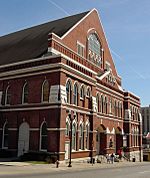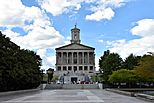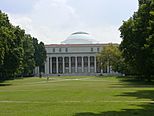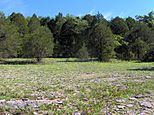Middle Tennessee facts for kids
Quick facts for kids
Middle Tennessee
|
|
|---|---|
|
Grand Division
|
|
|
Images, from top down, left to right: Skyline of Nashville, the Tennessee State Capitol, the Ryman Auditorium, Stones River National Battlefield in Murfreesboro, Vanderbilt University, Fall Creek Falls, Cedars of Lebanon State Park
|
|
| Nickname(s):
Middle TN, Middle Tenn.
|
|

The counties of Tennessee highlighted in red that are designated part of Middle Tennessee.
|
|
| Country | |
| State | |
| Largest city | Nashville |
| Area | |
| • Land | 44,054.2 km2 (17,009.41 sq mi) |
| Population
(2020)
|
2,883,086 |
| • Density | 65.44/km2 (169.50/sq mi) |
| Demonym(s) | Middle Tennessean |
Middle Tennessee is one of the three Grand Divisions of the U.S. state of Tennessee that composes roughly the central portion of the state. It is delineated according to state law as 41 of the state's 95 counties. Middle Tennessee contains the state's capital and largest city, Nashville, as well as Clarksville, the state's fifth largest city, and Murfreesboro, the state's sixth largest city and largest suburb of Nashville. The Nashville metropolitan area, located entirely within the region, is the most populous metropolitan area in the state, and the Clarksville metropolitan area is the state's sixth most populous. Middle Tennessee is both the largest, in terms of land area, and the most populous of the state's three Grand Divisions.
Geographically, Middle Tennessee is composed of the Highland Rim, which completely surrounds the Nashville Basin. The Cumberland Plateau is located in the eastern part of the region. Culturally, Middle Tennessee is considered part of the Upland South. Commodity crops such as cotton and tobacco were cultivated by migrant settlers in the region in the antebellum era, who were largely dependent on the labor of enslaved African Americans. In addition, planters bred and trained livestock, such as the world-famous Tennessee Walking Horse, which was developed as a breed in the region during this time.
Middle Tennessee was an extremely crucial region during the American Civil War. Tennessee was occupied by Federal troops from 1862 through the end of the war. Many battles and campaigns were waged by Confederates in this region, especially in efforts to control the major rivers. Confederate General Nathan Bedford Forrest conducted extensive raids through this area, destroying many Union assets in the 1864 Battle of Johnsonville.
In the 20th century, the Grand Ole Opry was established in Nashville, enhancing the city as the home of country music. Since the early 1970s, the region has been transformed by the entry of many new economic sectors, including automotive manufacturing, healthcare, finance, technology, tourism, and professional services. Both the Nashville and Clarksville metropolitan areas are among the fastest-growing regions in the nation.
Contents
Climate
| Climate data for Nashville (Nashville Int'l), 1981–2010 normals, extremes 1871−present | |||||||||||||
|---|---|---|---|---|---|---|---|---|---|---|---|---|---|
| Month | Jan | Feb | Mar | Apr | May | Jun | Jul | Aug | Sep | Oct | Nov | Dec | Year |
| Record high °F (°C) | 78 (26) |
84 (29) |
89 (32) |
91 (33) |
96 (36) |
109 (43) |
107 (42) |
106 (41) |
105 (41) |
94 (34) |
88 (31) |
79 (26) |
109 (43) |
| Mean maximum °F (°C) | 68.0 (20.0) |
73.0 (22.8) |
80.2 (26.8) |
85.1 (29.5) |
88.7 (31.5) |
94.2 (34.6) |
97.1 (36.2) |
96.5 (35.8) |
93.0 (33.9) |
85.5 (29.7) |
77.7 (25.4) |
68.5 (20.3) |
98.3 (36.8) |
| Mean daily maximum °F (°C) | 46.9 (8.3) |
51.8 (11.0) |
61.0 (16.1) |
70.5 (21.4) |
78.2 (25.7) |
86.0 (30.0) |
89.3 (31.8) |
89.0 (31.7) |
82.4 (28.0) |
71.7 (22.1) |
60.3 (15.7) |
49.5 (9.7) |
69.7 (20.9) |
| Mean daily minimum °F (°C) | 28.4 (−2.0) |
31.6 (−0.2) |
39.0 (3.9) |
47.5 (8.6) |
56.8 (13.8) |
65.4 (18.6) |
69.5 (20.8) |
68.4 (20.2) |
60.7 (15.9) |
48.9 (9.4) |
39.4 (4.1) |
31.3 (−0.4) |
48.9 (9.4) |
| Mean minimum °F (°C) | 8.8 (−12.9) |
13.5 (−10.3) |
22.5 (−5.3) |
31.2 (−0.4) |
42.7 (5.9) |
54.3 (12.4) |
61.6 (16.4) |
59.4 (15.2) |
45.4 (7.4) |
32.7 (0.4) |
23.8 (−4.6) |
13.8 (−10.1) |
4.7 (−15.2) |
| Record low °F (°C) | −17 (−27) |
−13 (−25) |
2 (−17) |
23 (−5) |
34 (1) |
42 (6) |
51 (11) |
47 (8) |
36 (2) |
26 (−3) |
−1 (−18) |
−10 (−23) |
−17 (−27) |
| Average precipitation inches (mm) | 3.75 (95) |
3.94 (100) |
4.11 (104) |
4.00 (102) |
5.50 (140) |
4.14 (105) |
3.64 (92) |
3.17 (81) |
3.41 (87) |
3.04 (77) |
4.31 (109) |
4.24 (108) |
47.25 (1,200) |
| Average snowfall inches (cm) | 2.6 (6.6) |
2.3 (5.8) |
0.9 (2.3) |
0 (0) |
0 (0) |
0 (0) |
0 (0) |
0 (0) |
0 (0) |
trace | 0 (0) |
0.5 (1.3) |
6.3 (16) |
| Average precipitation days (≥ 0.01 in) | 10.3 | 10.3 | 10.7 | 10.8 | 11.7 | 10.0 | 10.2 | 8.4 | 7.5 | 8.0 | 9.8 | 11.2 | 118.9 |
| Average snowy days (≥ 0.1 in) | 2.1 | 2.3 | 0.7 | 0 | 0 | 0 | 0 | 0 | 0 | 0.1 | 0 | 1.0 | 6.2 |
| Average relative humidity (%) | 70.4 | 68.5 | 64.6 | 63.2 | 69.5 | 70.4 | 72.8 | 73.1 | 73.7 | 69.4 | 70.2 | 71.4 | 69.8 |
| Mean monthly sunshine hours | 139.6 | 145.2 | 191.3 | 231.5 | 261.8 | 277.7 | 279.0 | 262.1 | 226.4 | 216.8 | 148.1 | 130.6 | 2,510.1 |
| Percent possible sunshine | 45 | 48 | 52 | 59 | 60 | 64 | 63 | 63 | 61 | 62 | 48 | 43 | 56 |
| Source: NOAA (relative humidity and sun 1961−1990), Weather.com | |||||||||||||
Economy
A diversity of sectors drives Middle Tennessee's economy, including music and entertainment, automotive manufacturing, healthcare, and technology. The region's economy is reportedly one of the fastest growing in the United States.
Music and entertainment
Nicknamed "Music City", Nashville is perhaps best known as the home of country music. The Big Three record labels, as well as numerous independent labels, have offices in Nashville, mostly in the Music Row area. Today, Nashville is the second-largest music recording center, behind New York City. Nashville's music industry is estimated to have a total economic impact of about $10 billion per year and to contribute approximately 56,000 jobs to the Nashville area.
Business
The largest service industry in Middle Tennessee is healthcare. More than 300 healthcare firms are based in the Nashville area, including Hospital Corporation of America (HCA), the world's largest private operator of hospitals, Community Health Systems, the largest provider of general hospital services in the United States, Envision Healthcare, Vanguard Health Systems, Ardent Health Services, and LifePoint Health. Other important business sectors in the region include banking, finance, insurance, and publishing. The technology sector is also rapidly becoming an important aspect of Middle Tennessee's economy, with such tech giants as Amazon and Oracle pledging investments in the area in 2018 and 2021, respectively, that are expected to employ thousands. Other major corporations headquartered in Middle Tennessee include Caterpillar Inc. in Nashville, Acadia Senior Living in Franklin, Dollar General in Goodlettsville, Tractor Supply Company and Delek US in Brentwood, and Cracker Barrel in Lebanon.
Industry
Automotive manufacturing is the largest manufacturing sector in Middle Tennessee. Nissan operates an assembly plant in Smyrna, which is the largest automotive assembly plant in North America, and also operates an engine plant in Decherd. General Motors operates an assembly plant in Spring Hill that was formerly the sole manufacturing facility for Saturn Corporation. Nissan relocated its North American headquarters from California to Franklin in 2005, and Mitsubishi Motors did the same in 2019. Bridgestone has its North American corporate headquarters in Nashville, and operates manufacturing facilities throughout the region. Middle Tennessee is home to several automotive parts suppliers scattered throughout the region. Other products manufactured in Middle Tennessee include processed foods, consumer electronics, electrical equipment, computer products, chemicals, and firearms.
Agriculture
Soybeans and tobacco are grown throughout Middle Tennessee, and beef cattle is raised throughout the region. Middle Tennessee is perhaps best known for its horticultural products and for being a prime breeding ground for horses. Warren County is one of the top producers of nursery products in the nation, and is nicknamed the "Nursery Capitol of the World". The soils of the Nashville Basin reportedly produce grasses which are favorable to horses, and as a result, the region is a top equestrian location. The Tennessee Walking Horse was first bred in the region in the late 18th century and is today one of the most recognized horse breeds in the world. The Cumberland Plateau is a major source of timber, and reportedly ranks as one of the top producers of hardwood in the country.
Energy
The Tennessee Valley Authority (TVA) provides electric power to Middle Tennessee. TVA operates coal and gas fired plants in the region, including the Cumberland Fossil Plant, Gallatin Fossil Plant, and the Johnsonville Combustion Turbine Plant, as well as several hydroelectric dams. In addition, TVA also purchases power from dams on the Cumberland River and its tributaries operated by the United States Army Corps of Engineers. The largest provider of power to the region, however, is the Browns Ferry Nuclear Plant in northern Alabama, the second-largest nuclear plant in the United States.
Tourism

Tourism plays a major role in Middle Tennessee's economy. Nashville has the largest tourism economy in the state, and contains many attractions, mostly related to its musical heritage. Top attractions in the region include the Grand Ole Opry, Country Music Hall of Fame and Museum, Ryman Auditorium, Gaylord Opryland Resort & Convention Center, Johnny Cash Museum, National Museum of African American Music, Frist Art Museum, The Parthenon, the Tennessee State Museum, and Jack Daniel's Distillery. A number of antebellum residences are preserved in the region, including The Hermitage, the home of Andrew Jackson, the Belle Meade Plantation, and several homes in Franklin. The National Park Service preserves two Civil War battlefields in Middle Tennessee: Fort Donelson National Battlefield near Dover, and Stones River National Battlefield in Murfreesboro. In addition, the American Battlefield Trust operates the Franklin Battlefield. The Natchez Trace Parkway begins in Nashville, and runs through the southwestern part of Middle Tennessee. In addition, the state operates many state parks in Middle Tennessee that preserve historic sites and natural features of the region.
Population and demographics
| Historical population | |||
|---|---|---|---|
| Census | Pop. | %± | |
| 1790 | 7,042 | — | |
| 1800 | 32,183 | 357.0% | |
| 1810 | 160,360 | 398.3% | |
| 1820 | 290,674 | 81.3% | |
| 1830 | 381,892 | 31.4% | |
| 1840 | 419,129 | 9.8% | |
| 1850 | 483,179 | 15.3% | |
| 1860 | 504,431 | 4.4% | |
| 1870 | 558,336 | 10.7% | |
| 1880 | 661,870 | 18.5% | |
| 1890 | 708,584 | 7.1% | |
| 1900 | 778,192 | 9.8% | |
| 1910 | 803,672 | 3.3% | |
| 1920 | 828,382 | 3.1% | |
| 1930 | 868,396 | 4.8% | |
| 1940 | 956,659 | 10.2% | |
| 1950 | 1,023,994 | 7.0% | |
| 1960 | 1,105,138 | 7.9% | |
| 1970 | 1,236,614 | 11.9% | |
| 1980 | 1,510,077 | 22.1% | |
| 1990 | 1,684,825 | 11.6% | |
| 2000 | 2,081,346 | 23.5% | |
| 2010 | 2,455,911 | 18.0% | |
| 2020 | 2,883,086 | 17.4% | |
| Source: 1910–2020 | |||
Middle Tennessee is the largest in area and most populated of the state's three Grand Divisions. At the 2020 census it had 2,883,086 inhabitants living in its 41 counties, an increase of 427,175, or 17.39%, over the 2010 figure of 2,455,911 inhabitants. This represented the region's largest net population increase in history. Its population was 41.72 percent of the state's total. Its population density was 169.50 inhabitants per square mile (65.44/km2), making it the second-most densely populated Grand Division, behind East Tennessee. Prior to the 2010 census, Middle Tennessee was the second-most populous of the state's Grand Divisions, behind East Tennessee.
Cities and metropolitan areas
Nashville, the state's capital and largest city, is located in north-central Middle Tennessee. It has nearly 700,000 residents, and anchors a 13-county metropolitan area with about 2 million residents that has been Tennessee's largest since the early 1990s. Clarksville, with a population of about 170,000, is Middle Tennessee's second-largest city and the fifth-largest statewide. It is located in the northwest corner of the region near Kentucky. Murfreesboro, located about 35 miles (56 km) southeast of Nashville, is Middle Tennessee's third-largest city, with more than 150,000 residents. It is also the sixth-largest city in Tennessee and the largest suburb of Nashville. Other important suburbs of Nashville include Franklin, Hendersonville, Smyrna, Spring Hill, Gallatin, Mount Juliet, Lebanon, Columbia, Dickson, and Springfield.
In addition to the Nashville and Clarksville metropolitan areas, Cookeville, located in the eastern part of the region, and Shelbyville, located about 50 miles (80 km) southeast of Nashville, anchor important population centers in Middle Tennessee. Other important cities in the region include Manchester, McMinnville, Tullahoma, Winchester, Lewisburg, and Lawrenceburg.
|
Largest cities or towns in Middle Tennessee
Source: |
||
|---|---|---|
| Rank | Pop. | |
| 1 | Nashville | 689,447 |
| 2 | Clarksville | 166,722 |
| 3 | Murfreesboro | 152,769 |
| 4 | Franklin | 83,454 |
| 5 | Hendersonville | 61,753 |
| 6 | Smyrna | 53,070 |
| 7 | Spring Hill | 50,005 |
| 8 | Brentwood | 45,373 |
| 9 | Gallatin | 44,431 |
| 10 | Columbia | 41,690 |
Education
Middle Tennessee has an abundance of institutions of higher learning—most notably Vanderbilt, Belmont, Lipscomb, and Tennessee State universities in Nashville and Tennessee Tech University in Cookeville. Other prominent universities are Austin Peay State University in Clarksville, the University of the South in Sewanee, Cumberland University in Lebanon, and Middle Tennessee State University in Murfreesboro, which is the state's second-largest institution of higher learning, just behind the University of Tennessee in Knoxville.
Transportation
Roads
Interstate 40 (I-40) traverses Middle Tennessee in an east to west alignment, passing through Nashville and its suburbs to the east. Interstate 65 (I-65) runs north to south through the region, serving Nashville and its suburbs to the north and south, including Brentwood, Franklin, and Spring Hill. Interstate 24 (I-24) enters the region in Clarksville and runs in a southeast to northwest alignment, passing through Nashville and its southeastern suburbs of La Vergne, Smyrna, and Murfreesboro, before exiting the region in the southeast. I-440 serves as a bypass around downtown Nashville, and I-840 is an outer bypass around Nashville, passing though suburban counties to the south. Other important freeways in Middle Tennessee include State Route 155 (SR 155/Briley Parkway), a northern bypass around downtown Nashville, Ellington Parkway, part of U.S. Route 31E (US 31E) in Nashville, SR 386 (Vietnam Veterans Boulevard), which serves Nashville's northwestern suburbs of Hendersonville and Gallatin, and SR 396 (Saturn Parkway), which connects Spring Hill and its General Motors plant to I-65. Middle Tennessee also has several other important corridors that are part of the National Highway System (NHS), including U.S. Routes 43, 64, 70S, 79, and 231, and State Routes 55 and 111.
Air, rail, and water
Nashville International Airport (BNA) is the region's primary airport and the busiest airport in Tennessee. The Music City Star is a commuter rail service that serves Nashville and its eastern suburbs of Mt. Juliet and Lebanon. CSX Transportation operates most freight trackage in Middle Tennessee, and runs a classification yard in Nashville called Radnor Yard. Both the Cumberland and Tennessee rivers are navigable in Middle Tennessee.
Images for kids
-
Postcard with an illustration of the reconstruciton of Fort Nashborough
-
The Battle of Franklin, November 30, 1864












